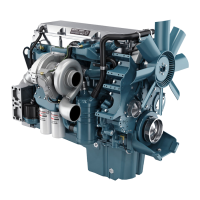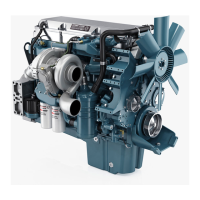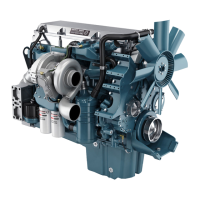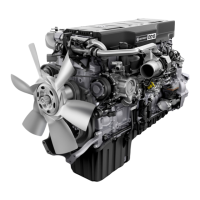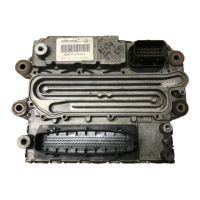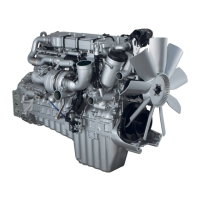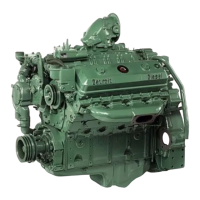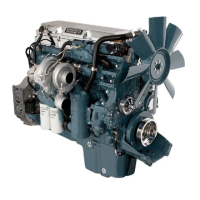
Do you have a question about the Detroit Diesel EPA07 Series 60 DDEC VI and is the answer not in the manual?
| Engine Model | Series 60 DDEC VI |
|---|---|
| Emissions Compliance | EPA 2007 |
| Aspiration | Turbocharged and Aftercooled |
| Engine Control System | DDEC VI |
| Displacement | 14.0 L |
| Fuel System | Electronic Unit Injector (EUI) |
| Bore | 130 mm |
| Stroke | 160 mm |
| Cooling System | Liquid-cooled |
Outlines essential safety measures to be observed when working on Detroit Diesel engines.
Troubleshooting steps for low oil pressure caused by incorrect engine oil level.
Procedure to determine if incorrect oil viscosity is causing low oil pressure.
Diagnosing low oil pressure due to fuel or coolant contamination in the oil.
Steps to determine if a faulty oil pressure gauge sensor is causing low oil pressure.
Troubleshooting low oil pressure related to missing rocker arm shaft plugs.
Procedure to determine if a restricted oil cooler is causing low oil pressure.
Diagnosing issues with a nonfunctional or sticking oil pressure regulator valve.
Troubleshooting steps for a defective bypass valve causing low oil pressure.
Steps to determine if a defective pressure relief valve is causing low oil pressure.
Diagnosing low oil pressure issues related to the pickup screen tube assembly.
Troubleshooting low oil pressure caused by defective crankshaft main bearing shells.
Steps to determine if a defective oil pump assembly is causing low oil pressure.
Troubleshooting misfires caused by a poor vehicle ground connection.
Diagnosing misfires caused by aerated fuel in the fuel system.
Procedure to determine if a faulty fuel injector is causing cylinder misfire.
Steps to determine if a faulty Motor Control Module (MCM) is causing misfires.
Diagnosing misfires due to worn or damaged valves or cylinder kits.
Troubleshooting starting difficulty when the fuel tank is empty.
Diagnosing starting issues caused by low battery voltage.
Steps to identify and resolve starting difficulties from battery terminal issues.
Troubleshooting a defective magnetic switch that prevents engine starting.
Procedure to determine if a defective starter is causing starting difficulty.
Diagnosing starting difficulty related to low engine cranking speed.
Checking if the fuel supply valve is causing starting difficulty.
Troubleshooting starting difficulty due to plugged fuel filters.
Diagnosing starting difficulty related to a faulty fuel pump.
Steps to determine if aerated fuel is causing starting difficulty.
Troubleshooting starting difficulty due to a restrictive air filter.
Diagnosing starting difficulty caused by low compression pressure.
Diagnosing issues when the engine cranks but does not start.
Troubleshooting the engine not starting due to a discharged battery.
Diagnosing a no-start condition caused by a defective magnetic switch.
Troubleshooting a no-start condition related to a defective starter.
Diagnosing a no-start condition due to internal engine damage.
Troubleshooting excessive oil consumption caused by external oil leaks.
Diagnosing excessive oil consumption from a leaking oil cooler core.
Troubleshooting excessive oil consumption due to a defective air compressor.
Diagnosing excessive oil consumption caused by a defective turbocharger.
Troubleshooting increased oil consumption from worn or damaged valve/cylinder kits.
Diagnosing excessive crankcase pressure due to rocker cover breather issues.
Troubleshooting excessive crankcase pressure caused by a defective air compressor.
Diagnosing excessive crankcase pressure related to a defective turbocharger.
Troubleshooting excessive crankcase pressure from worn/damaged valve or cylinder kits.
Diagnosing black or gray smoke caused by improper diesel fuel grade.
Troubleshooting excessive black/gray smoke from a restricted air cleaner element.
Diagnosing excessive exhaust smoke due to restricted or cracked charge air cooler.
Troubleshooting excessive exhaust smoke caused by a faulty exhaust system.
Diagnosing misfires and excessive exhaust smoke from a faulty fuel injector.
Troubleshooting excessive exhaust smoke related to a defective turbocharger.
Diagnosing excessive blue smoke caused by a defective turbocharger.
Troubleshooting blue smoke from worn or damaged valves or cylinder kits.
Diagnosing white smoke caused by improper fuel grade.
Troubleshooting white smoke related to a defective fuel pump.
Diagnosing white smoke caused by aerated fuel in the system.
Troubleshooting white smoke due to improper injector calibration settings.
Diagnosing white smoke from valve clearance or camshaft lobe issues.
Troubleshooting white smoke caused by a faulty fuel injector.
Diagnosing rough running or stalling due to low battery voltage.
Troubleshooting rough running or stalling caused by aerated fuel.
Diagnosing rough running or stalling due to insufficient fuel flow.
Troubleshooting rough running or stalling from high fuel temperature return.
Diagnosing rough running or stalling from improper injector calibration.
Troubleshooting rough running or stalling due to low compression pressure.
Diagnosing lack of power caused by aerated fuel.
Troubleshooting lack of power related to high fuel pressure.
Diagnosing lack of power due to high fuel temperature return.
Troubleshooting lack of power caused by a restricted air cleaner element.
Diagnosing lack of power from charge air cooler or intake manifold issues.
Troubleshooting lack of power caused by a faulty exhaust system.
Diagnosing lack of power related to high inlet air temperature.
Troubleshooting lack of power due to incorrect camshaft timing.
Diagnosing high coolant temperature caused by improper engine coolant level.
Troubleshooting high engine coolant temperature due to insufficient radiator airflow.
Diagnosing high engine coolant temperature caused by a faulty pressure control cap.
Troubleshooting high engine coolant temperature related to defective coolant hoses.
Diagnosing high engine coolant temperature due to incorrectly adjusted fan belts.
Troubleshooting high engine coolant temperature caused by an inoperative thermo-modulated fan.
Diagnosing high engine coolant temperature due to faulty thermostats.
Troubleshooting high engine coolant temperature caused by a faulty water pump.
Diagnosing high engine coolant temperature related to combustion gases in coolant.
Troubleshooting high engine coolant temperature due to abnormal radiator coolant flow.
Diagnosing low engine coolant temperature due to faulty thermostats.
Procedures for troubleshooting the air compressor.
Details on the Motor Control Module (MCM) and its role in engine management.
Information on the Common Powertrain Controller (CPC) and its interface functions.
General requirements and guidelines for wires and wiring used in the DDEC VI system.
Overview of sensors used with DDEC VI and their functions.
Troubleshooting EGR valve position circuit failure (high).
Diagnosing EGR valve position circuit failure (low).
Troubleshooting EGR valve stuck open condition.
Troubleshooting intake throttle valve issues related to operating range faults.
Diagnosing missing J1939 Park Brake Switch signal from Source #1, #2, or #3.
Troubleshooting erratic J1939 Park Brake Switch signal from Source #1, #2, or #3.
Diagnosing missing J1939 wheel-based vehicle speed signal from Source #1, #2, or #3.
Troubleshooting erratic J1939 wheel-based vehicle speed signal from Source #1, #2, or #3.
Troubleshooting SPN 84/FMI 2, typically VSS open circuit.
Diagnosing SPN 84/FMI 3, typically VSS open circuit.
Troubleshooting SPN 84/FMI 4, typically VSS circuit failed low.
Troubleshooting SPN 84/FMI 6.
Diagnosing SPN 84/FMI 8.

